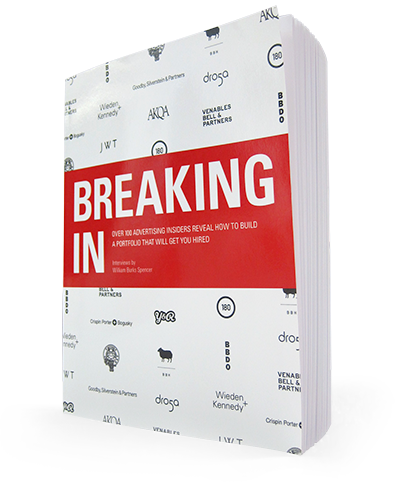If you missed it, take a look at some great TV spots from Jose Mollá and La Comunidad.
WS: What do you look for in a student book? And what impresses you?
JM: First of all, students have to keep in mind that the main thing creative directors don’t have is time. To me a book should show where your standard and criteria is. I don’t care about quantity that much. I’d rather see seven or eight ads that are really good than 20 that are okay, because with your portfolio you are saying, “Okay, this is what I think is really good.” Of course it’s great if you have 20 great ads but I think it’s also good to leave someone wanting to see more.
The first page of the book makes a big statement, and it can change the way you see the rest of the book so it should be really strong. The end is also important because it will drive the desire to want to know more about you and your work. So, choose your best ads for the beginning and the end, but make sure what’s in between doesn’t kill the thrill.
It’s also important to try and show good ideas on different platforms. Something that worked for me when I was starting out was to describe TV ideas, for example, with just brief paragraphs, telling the core of the story, using as few words as possible. Keep your audience in mind—you are talking to people who are accustomed to imagining things, that’s what they do for a living. Never ever have long scripts; believe me, nobody will ever read them. Make sure you have a healthy mix of print, out of home, TV, interactive, some guerrilla, even some radio is nice, only if it’s good, though. But don’t overdo it. Less is more.
WS: Do you think it’s important to have TV in a student book?
JM: I think it’s key to show you can think in TV and interactive terms. Here’s another good tip when it comes to TV: don’t try to shoot stuff. There’s a reason why directors and production houses are so expensive. Good TV is very hard to produce. The democratization of technology is not helping students. Knowing where you place a camera or how to shoot a spot is not what will open doors for you as a creative. Coming up with great ideas will, and that’s what will give you the chance to work with the best directors and editors who you will eventually learn from after many years.
Just write, in five lines, what the idea is and end with the concept and VO. The idea will always look better in the creative director’s mind, especially if you are talking to the right creative director. And if you are not, then you don’t want to work for him or her anyway.
WS: Do you think just sketches can be enough? Or do you think ads need to be produced and comped up?
JM: Please don’t be pretentious when it comes to the actual book. When I see really fancy, expensive books, immediately I think, “Wow, the content better be good.” So it can actually backfire because it sets expectations high even before looking at the work. And, if the content is not good then it makes it even worse. On the other hand, when I see a book that is “normal” and I open it to find some great ideas, the surprise is very pleasant. Students get too obsessed about their books and they redo the same ad 35 times and they spend lots of money they may not have. Personally, I think sketches are okay. Again, the imagination of a creative director can be a powerful ally.
Another piece of advice is to be careful when deciding what products to put in your book. This is basic. A good ad for laundry detergent is ten times stronger than a good ad for condoms and it looks more professional.. Stay away from funky products and brands and choose more “serious” advertisers. Also, stay away from iconic brands. Every time you see ads in student books for Nike, Apple, MTV, etc., it’s impossible not to compare it with all the great work that has been done for those brands before. So all that great work will go against you. Having good ads featuring serious brands adds more to the equation. You should make us think, “Wow, if he or she can do a good ad for a product like this, imagine what they could do in other categories.” It should create the feeling, again, of wanting to see more.
When I taught, I would give my students an assignment and tell them, “Okay, you have to develop a campaign for a shampoo with only one condition: you cannot show hair.” And the stuff I would get was actually much cooler despite them being shocked in the beginning. They would come in with the perception that it’s much harder to do a good shampoo commercial than a good condom commercial. But in reality, both are equally hard.


Comments are closed.